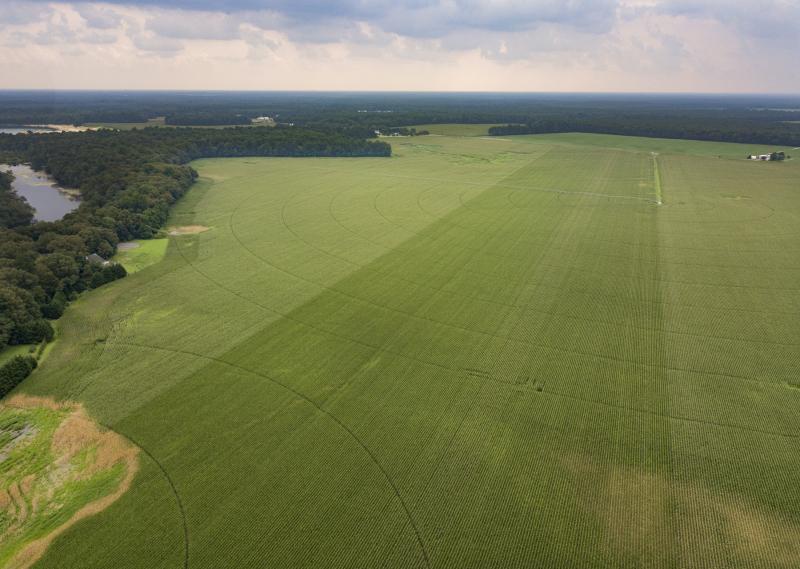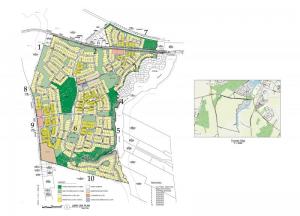Milton planners begin review of Granary master plan

The Milton Planning and Zoning Commission has begun its review of the master plan for the proposed 1,350-unit development known as the Granary at Draper Farm.
At an Aug. 16 public hearing, Colby Cox, founder of developer Convergence Communities, laid out the details of the master plan, required by code because the Granary is a large-parcel development.
“The vision for this community is that it is part of the town. It looks like a vision that in 150 or 200 years, this property is embedded in the town and is indistinguishable,” Cox said.
Convergence has divided the Granary into 10 sections, with each section representing the order in which the development is proposed to be built.
Planning and Zoning Chair Richard Trask said the master plan process is all about configuration and placement, and not about engineering detail. He said the purpose is to find out where things go and how that placement benefits the greater community.
“We want to look at the entire plan and see how it fits within the confines of our code, the confines of the town and the confines of the marketing vision for this community,” Trask said.
Among the issues of contention for the commission was emergency access, particularly in the proposed Section 7, which, unlike the rest of the development, is on the other side of Sand Hill Road backing up to portions of Wagamon’s West Shore. For the commission, the problem is that this part of the development has only one way in and one way out. Commission members suggested eliminating a lot in Section 7 and using it to provide a second access via Lavinia Street.
Zac Crouch, engineer for the project, said the section is large enough to accommodate a fire truck, and that access to the parcel is determined by Delaware Department of Transportation, which he said will not let them put in turn lanes on Lavinia Street.
The commission also asked about vegetative buffers surrounding the parcel. Cox said it’s his goal to have buffers, but to not have what he termed a “large wall between us and the community.” Cox also said he was not planning to have bright lighting around the property, saying he did not want it to look like a baseball diamond; however, how that would be accomplished is still under consideration. He said it was his intention to have what he called down lighting, which would point the light down toward the street and minimize light around the community.
The commission decided to table a decision on the master plan to allow for changes to the plan. Cox agreed to bring additional detail to the commission’s next meeting. Town Solicitor Seth Thompson said the master plan process is only the beginning, with the Granary still subject to site-plan review. The commission’s next meeting is scheduled for Tuesday, Sept. 20.
Convergence is planning a 20-year buildout of the development, which would comprise 65% single-family homes and 35% townhouses. The 450-acre parcel was formally annexed into town in March.
Cox has said 25% of the property would be left undeveloped as open space or woodlands, with 55 acres dedicated to the town for park space, which would include an athletic field. The Granary would also include a three-mile walking trail connecting with the existing Rails to Trails through an underpass beneath Sand Hill Road, along with a vegetative buffer between the development and nearby Diamond Pond. Convergence also plans to give the town five acres for the town’s own use.
As part of a cost-benefit analysis by the special review committee, it was determined that over the buildout period, the town would need to add six new police officers and six employees in the public works department, plus vehicles. The analysis showed the town stands to make $15 million in taxes and fees from the development against $3.3 million in expenses between the prospective groundbreaking in 2024 and the end of buildout in 2043.
Milton council to hold Sept. 12 hearing on special development district
While planning and zoning has begun drilling into the nuts and bolts of the Granary project, Milton Town Council is working on another aspect of the project: designating the Granary as a special development district.
This is a mechanism by which Granary property owners would pay a levy on top of their property tax that will go toward paying for public infrastructure needed to serve the development. The special tax would eventually expire and would likely be between $1,000 and $2,000 per home annually. Under a special development district, the town would issue bonds, with the proceeds covering those costs. The town would then be paid back through the additional tax. This does not include infrastructure such as roads or water and sewer hookups, which are the direct responsibility of the developer.
While one of the benefits of the Granary annexing into Milton is that it gets town fire, police, water and street maintenance - sewer will be handled by Artesian and electricity will be provided by Delaware Electric Cooperative - that infrastructure comes with a cost. The town has estimated it will need to hire six people each in the public works and police departments over the Granary’s 20-year development time frame, along with buying vehicles. The town’s projections have shown tax revenue benefits from annexing the parcel outweigh expenses over the development period. Developer Colby Cox has said that is where the special development district designation comes in.
Under a special development district, the levy is on Granary residents, not current homeowners in Milton. Cox has said the plan is for some of the money raised by the district to go to infrastructure needs outside of the Granary to benefit the whole town.
At council’s 6:30 p.m., Friday, Sept. 12 meeting, a public hearing will be held on whether to create the district itself. Following that hearing, later in the meeting, council will discuss and possibly vote on a resolution that would create the district. This would not commit the town to anything, but would open the door for Convergence and town officials to come together and hash out details.
Ryan Mavity covers Milton and the court system. He is married to Rachel Swick Mavity and has two kids, Alex and Jane. Ryan started with the Cape Gazette all the way back in February 2007, previously covering the City of Rehoboth Beach. A native of Easton, Md. and graduate of Towson University, Ryan enjoys watching the Baltimore Ravens, Washington Capitals and Baltimore Orioles in his spare time.



















































